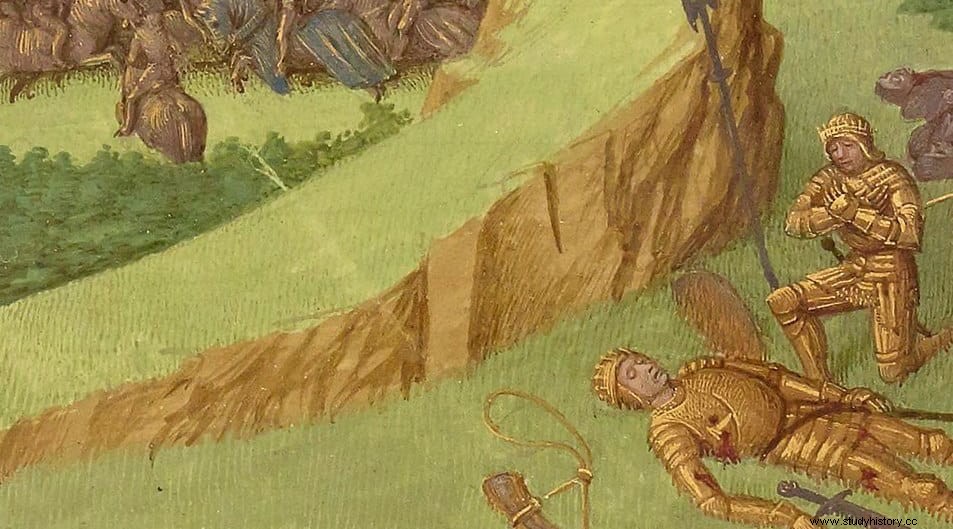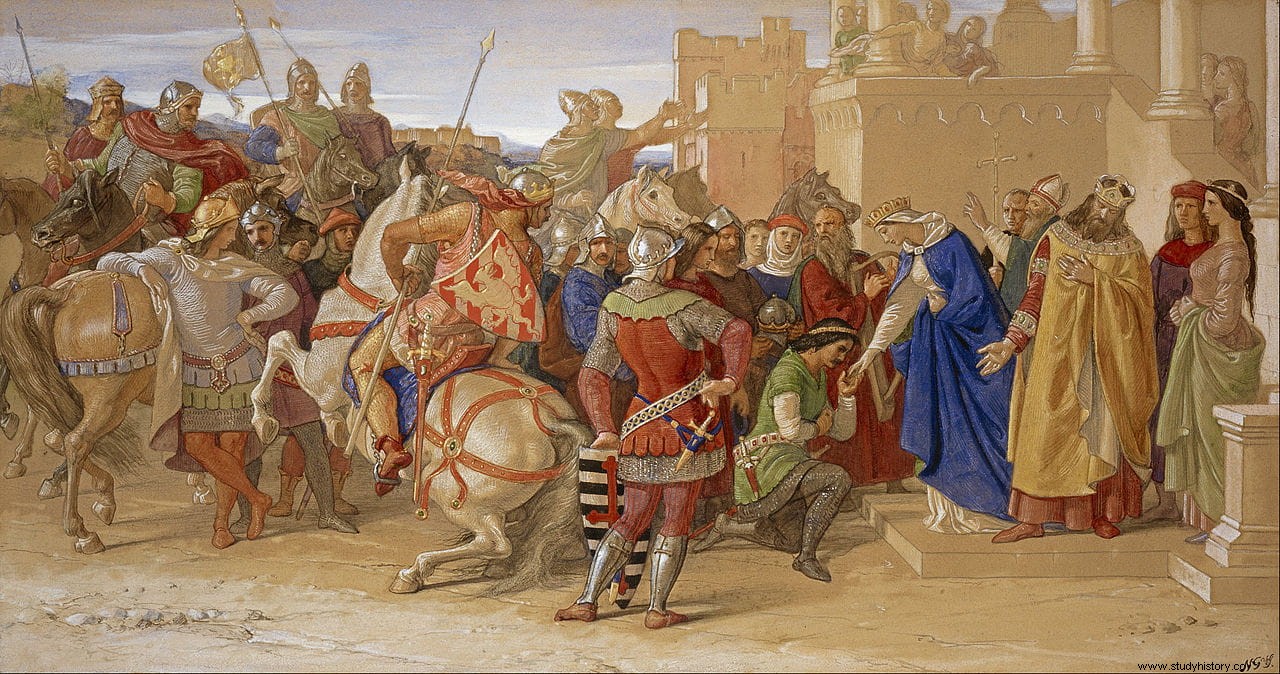"Strong and courageous knight who, volunteering in war, is distinguished by his deeds" and “strong advocate of someone or something «. Those are the two meanings with which the RAE defines the term paladin, which we currently and generally associate with the classic image of the knight-errant. But paladin, whose etymology comes from the Latin palatinus (palatial), was also the generic name of the twelve legendary knights of Charlemagne's court, as recounted in the chansons de geste and, above all, the Chanson de Roland :the Twelve Paladins or Peers.
The song of Roland (in Spanish) is an epic poem written between the years 1040 and 1115 in language of oil (Romance) and attributed to a religious, like almost all:a Norman monk named Turoldo. It consists of four thousand ten-syllable verses, structured in laisses (a type of stanza equivalent to the spread), in which the adventures of the title character are told. This one was actually just a margrave (Marquis) of Brittany who lived three centuries earlier and who in the play happens to be the nephew of an elderly Charlemagne. Together with his inseparable friend Oliveros and the other eleven Peers, he accompanies the emperor beyond the Pyrenees to negotiate a peace offer from the Muslims of Zaragoza.

So he enters Al Andalus and, on the way back, commanding the imperial rearguard, he finds himself in a trap hatched by his stepfather, who wants revenge for his bravado, the same one that will lose him by not wanting to ask for help when the Saracens fall on him. them in great numbers. It takes place in Roncesvalles, recalling a historical ambush only unleashed by Basques instead of Muslims. Charlemagne finally comes to his aid but too late, for Roldán has bravely died in combat alongside his faithful friend. Ganelon, the treacherous stepfather, will be convicted after an ordeal and executed.
No one will miss a certain similarity between this argument and that of the Arthurian cycle that in Great Britain (including French Brittany, then English) glosses the adventures of King Arthur and his Knights of the Round Table. Nor will it go unnoticed that there are twelve paladins, a number with a clear reference to the Christian Apostles, although the number varies in other romances. Their names, according to The song of Roldán , would be -apart from the named- Rhobar, Gérin, Gérier, Bérengier, Otton, Samson, Engelier, Ivon, Ivoire, Anséis, Girard and Cecil; all of them star in numerous exploits, like their British counterparts Lancelot, Perceval, Gawain, Galahad and others.

We said that in other works there are some changes and some characters are added to the list of paladins than in the Song of Roldán they are not such, like Ogier the Dane (prince of Denmark who, after several years of enmity with Charlemagne, joins him against the Muslims and manages to finish off the giant Brehus in battle) or the archbishop-warrior Turpin (who really existed and was the author of a Story Caroli Magni, although in real life he never fought and was dedicated to his parish of Reims Cathedral ).
Among those other epic songs that make up what is known as Matière de France (three great series or cycles of which we are concerned is the Carolingian, also called Geste du Roi or Pepin), we can cite, among others, Le Pèlerinage de Charlemagne (The Pilgrimage of Charlemagne, from the 12th century, in which the characters accompany the emperor on a trip to Jerusalem and Constantinople) and Fierabras (also from the XII, starring the gigantic Saracen knight Fierabrás, who confronts the paladins after sacking Rome, but ends up converting to Christianity and entering the service of Charlemagne). However, the twelve did not limit their adventures to the literature of the Middle Ages; they also found a place in the later Renaissance.

This is the case of Orlando in love , famous epic poem by the Modena Matteo Maria Boiardo published in 1486 in which the knight Orlando (Italianization of Roland) and several of his companions leave aside the arts of war to focus on love affairs, in pursuit of a beautiful lady named Angelica . Another Italian poet, Ludovico Ariosto, wrote in 1516 a continuation entitled Orlando furioso which begins where the previous one ends -in the defeat of Charlemagne at Roncesvalles- and has the same fantastic tone that Boiardo had given it. The twelve knights appear again, with the curiosity that there is an interaction between the characters of the Carolingian cycle and those of the Arthurian cycle.
Orlando furious had a considerable influence on works such as Don Quixote (especially for a version translated in 1521 and entitled The history of the emperor Charlemagne and the twelve peers of France , which Cervantes often cites) or La Araucana (in which Alonso de Ercilla imitates the narrative structure), apart from serving as an inspiration to other authors of the Spanish Golden Age:Barahona de Soto and Lope de Vega, with their respective chivalric poems The tears of Angélica and Angélica's beauty , Bernardo de Balbuena with his El Bernardo (which has the peculiarity of having been written in America, in 1624) and many more.
In fact, the Carolingian cycle left its mark not only in Spain and Italy but also in other countries. These are the cases of Portugal (where, in the 18th century, Moreira de Carvalho made a sequel to The story of Emperor Charlemagne and the twelve peers of France and Alberto Rodrigues published New History of Emperor Charles the Great, and two twelve pairs of França , later continued by Alexandre Caetano Gomes Flaviens) and Norway (which in the 13th century gave birth to the Karlamagnús, saga in Old Norse). In the baroque era, Orlando furioso it was musically adapted to opera by Caccini, Rossi, Steffani, Vivaldi, Lully and Rameau, among others, although the most famous are the three made by Handel. Even the cinema has given more than one film.

So we have a dozen paladins who were Charlemagne's immediate supporters. Now, where does the story end and where does the legend begin? We said before that the word comes from the Latin palatinus , which was used in ancient Rome to designate the chamberlain, an official of the officium palatinum who was in charge of the emperor's chamber and owed that name to the location of the imperial residence on the Palatine Hill (in medieval Castile that position was renamed main waiter and in the Vatican he is known today as camarlengo ).
Later, Merovingians and Carolingians created a special administrative position called comes palatinus i.e. count palatine. It was more important than the others (there was comes cubiculariorum , comes stabulorum , comes scanciorum …) Because, in addition to taking care of the royal house, he represented the crown in the courts of justice, assuming full powers. Over time, the counts palatine did not limit their activity to the emperor's environment but became his delegates in other regions, sometimes as judges, sometimes as governors and sometimes as both, which linked them to the lands where they acted. , as in the other counties.

Therefore, although they are based on a real institutional figure, the Twelve Paladins of Charlemagne belong exclusively to the literary field, that of the aforementioned Carolingian cycle, which, as we have explained, drew from the Arthurian and was influenced by the historical context of the Muslim attempt to invade Trans-Pyrenees. Gallic land, embodied in the conflict between the Franco Empire and the Emirate of Córdoba -which led to the creation de facto of the Hispanic March in 795-. But there was also the example of classical mythology, which was just another cycle, as the poet Jehan Bodel enunciated in the 12th century in his Chanson des Saisnes (Song of the Saxons):
